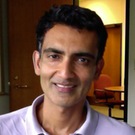Onawa Gardiner, Marketing Specialist
@onawanna
As we continue to enable engaged, personalized and lifelong learning for the Michigan community and learners around the world, we are committed to providing a diversified range of MOOCs that are accessible to global learners and learners in different stages of their education and careers. With this approach, we strive to develop MOOCs intended for novice learners while also recognizing the needs of advanced learners seeking to strengthen their knowledge base and skill set in a specialized area.
Professor Krishna Garikipati has developed two specialized MOOCs focused on physics that are specifically designed for advanced learners seeking to gain greater understanding of specialized methods in physics, which play a fundamental role in a number of research, education and industrial fields: The Finite Element Method in Physics and the Lectures in Continuum Physics. We recently sat down with him and discussed his inspiration for developing these courses, as well as his experience teaching specialized courses through an open format with a globalized audience.
What was the inspiration for developing specialized MOOCs that target advanced learners, rather than a broader, generalized audience?
The inspiration comes from my research. In my group, we develop mathematical models that describe the physics of materials and biological systems, as well as the numerical methods and computational frameworks needed to investigate a range of interesting phenomena with them. This field, which I refer to as computational physics, is advanced stuff, but is important in a number of industrial settings (automotive, biomedical, electrical, semiconductor, manufacturing, chemical, structural…) in addition to representing a broad and active research area in academe. Advanced computer programming is also central to this type of research. About three years ago, I had been following the evolving conversation on MOOCs, and was intrigued by the idea of developing them for computational physics. I was encouraged particularly by the fact that the first MOOC was in a computer programming-heavy subject: artificial intelligence. The multifaceted nature of the community that is involved in computational physics, I felt, would offer an interested audience. The way that this has been borne out has actually exceeded my expectations.
How do your two MOOCs, the Finite Element Method for Problems in Physics and Lectures in Continuum Physics, aim to contribute to diversity, equity and inclusion, both residentially and globally?
The way the numbers break down, the Finite Element Method MOOC reaches scores of learners in Africa, hundreds in Latin America and thousands in South Asia. So, access is being provided to a very diverse audience. Comments in the forums suggest that many of these learners do not have access to brick and mortar campuses that teach these advanced topics. The open source/open access software packages that we used in the Finite Element Method MOOC are right at the cutting edge of computational physics research. I think it is very compelling that such a diverse audience is gaining this exposure that could set some members of that audience on the road to higher education with a research component, much like we have in the world’s best universities. Furthermore, to ensure that no learner would be left behind, we provided the entire software suite on Amazon Web Services (AWS), bundled in a manner that would not require resources beyond those available via AWS’ free instances. There is the possibility that some of these diverse, global learners will end up in residential universities, propelled by their exposure to these advanced MOOCs.
How does the global dissemination of these two MOOCs that focus on physics serve to expand learners’ foundational knowledge in the sciences?
We (I and my student Greg Teichert, who did the coding tutorial lectures) write out everything in both these MOOCs. No prepared slides, but a total of over 70 hours of physics and numerical methods written out painstakingly. Almost unanimously, the audience (global and residential) has expressed appreciation of this approach, which makes the mathematical content come alive. This, they insist, leads to far deeper foundational learning in the mathematical sciences.
What outcomes have you observed with learners who have taken the Finite Element Method for Problems in Physics MOOCs and what learning outcomes do you expect to see from students who take the Lectures in Continuum Physics MOOC?
Students of the Finite Element Method MOOC become proficient scientific programmers in modern programming languages, and learn how the careful development of the mathematical content leads to workable scientific code for computational physics. The Continuum Physics MOOC translates sophisticated mathematics to insight for the physics. I expect that those learners will see that connection very clearly.
To learn more about Professor Garikipati’s MOOCs on physics, visit: The Finite Element Method for Problems in Physics and Lectures on Continuum Physics.

Krishna Garikipati
Professor, Departments of Mechanical Engineering and Mathematics
College of Engineering and College of Literature, Science and the Arts
University of Michigan
@KrishnaGarikipa


